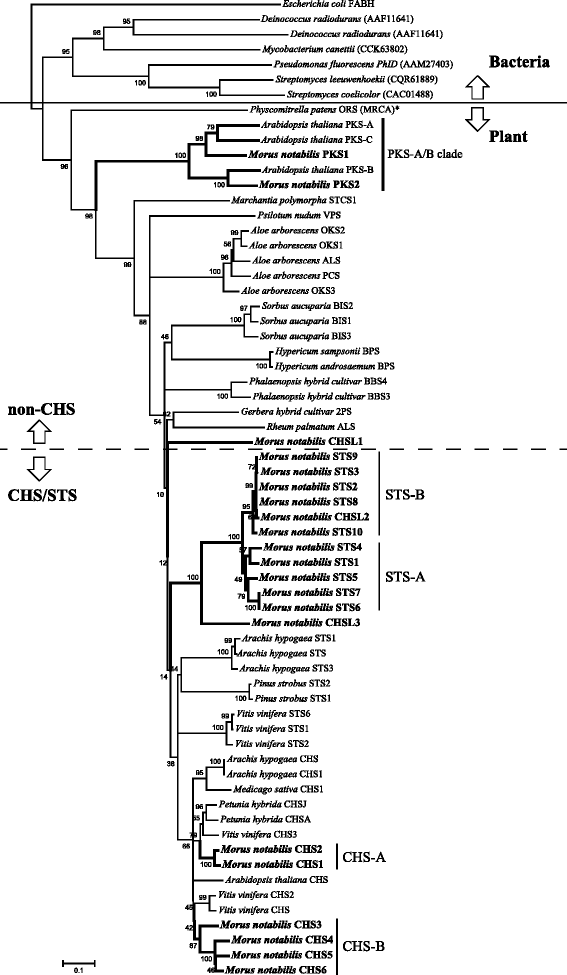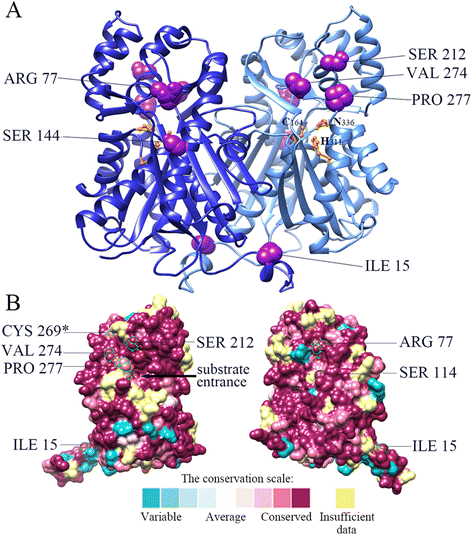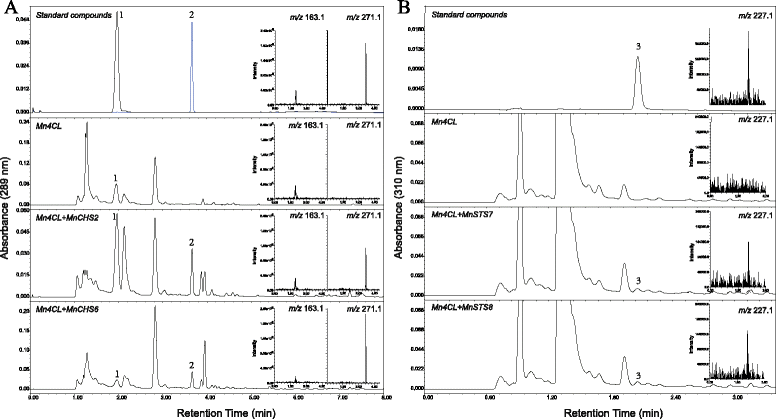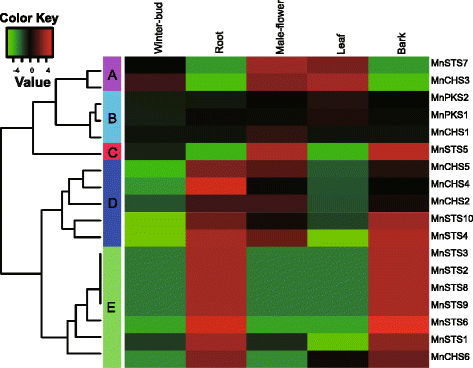Evolutionary and functional analysis of mulberry type III polyketide synthases
- PMID: 27487946
- PMCID: PMC4973071
- DOI: 10.1186/s12864-016-2843-7
Evolutionary and functional analysis of mulberry type III polyketide synthases
Abstract
Background: Type III polyketide synthases are important for the biosynthesis of flavonoids and various plant polyphenols. Mulberry plants have abundant polyphenols, but very little is known about the mulberry type III polyketide synthase genes. An analysis of these genes may provide new targets for genetic improvement to increase relevant secondary metabolites and enhance the plant tolerance to biotic and abiotic stresses.
Results: Eighteen genes encoding type III polyketide synthases were identified, including six chalcone synthases (CHS), ten stilbene synthases (STS), and two polyketide synthases (PKS). Functional characterization of four genes representing most of the MnCHS and MnSTS genes by coexpression with 4-Coumaroyl-CoA ligase in Escherichia coli indicated that their products were able to catalyze p-coumaroyl-CoA and malonyl-CoA to generate naringenin and resveratrol, respectively. Microsynteny analysis within mulberry indicated that segmental and tandem duplication events contributed to the expansion of the MnCHS family, while tandem duplications were mainly responsible for the generation of the MnSTS genes. Combining the evolution and expression analysis results of the mulberry type III PKS genes indicated that MnCHS and MnSTS genes evolved mainly under purifying selection to maintain their original functions, but transcriptional subfunctionalization occurred during long-term species evolution. Moreover, mulberry leaves can rapidly accumulated oxyresveratrol after UV-C irradiation, suggesting that resveratrol was converted to oxyresveratrol.
Conclusions: Characterizing the functions and evolution of mulberry type III PKS genes is crucial for advancing our understanding of these genes and providing the basis for further studies on the biosynthesis of relevant secondary metabolites in mulberry plants.
Keywords: Chalcone synthase; Evolutionary analysis; Functional analysis; Gene expression; Mulberry; Stilbene synthase.
Figures







Similar articles
-
Characterization of Stilbene Synthase Genes in Mulberry (Morus atropurpurea) and Metabolic Engineering for the Production of Resveratrol in Escherichia coli.J Agric Food Chem. 2017 Mar 1;65(8):1659-1668. doi: 10.1021/acs.jafc.6b05212. Epub 2017 Feb 14. J Agric Food Chem. 2017. PMID: 28168876
-
An aldol switch discovered in stilbene synthases mediates cyclization specificity of type III polyketide synthases.Chem Biol. 2004 Sep;11(9):1179-94. doi: 10.1016/j.chembiol.2004.05.024. Chem Biol. 2004. PMID: 15380179
-
Genome-wide analysis of the grapevine stilbene synthase multigenic family: genomic organization and expression profiles upon biotic and abiotic stresses.BMC Plant Biol. 2012 Aug 3;12:130. doi: 10.1186/1471-2229-12-130. BMC Plant Biol. 2012. PMID: 22863370 Free PMC article.
-
Stilbene and chalcone synthases: related enzymes with key functions in plant-specific pathways.Z Naturforsch C J Biosci. 1990 Jan-Feb;45(1-2):1-8. doi: 10.1515/znc-1990-1-202. Z Naturforsch C J Biosci. 1990. PMID: 2184816 Review.
-
Plant-like biosynthetic pathways in bacteria: from benzoic acid to chalcone.J Nat Prod. 2002 Dec;65(12):1956-62. doi: 10.1021/np020230m. J Nat Prod. 2002. PMID: 12502351 Review.
Cited by
-
Impact of Environmental Factors on Stilbene Biosynthesis.Plants (Basel). 2021 Jan 4;10(1):90. doi: 10.3390/plants10010090. Plants (Basel). 2021. PMID: 33406721 Free PMC article. Review.
-
Abnormal expression of bHLH3 disrupts a flavonoid homeostasis network, causing differences in pigment composition among mulberry fruits.Hortic Res. 2020 Jun 1;7(1):83. doi: 10.1038/s41438-020-0302-8. eCollection 2020. Hortic Res. 2020. PMID: 32528695 Free PMC article.
-
Flavones Produced by Mulberry Flavone Synthase Type I Constitute a Defense Line against the Ultraviolet-B Stress.Plants (Basel). 2020 Feb 7;9(2):215. doi: 10.3390/plants9020215. Plants (Basel). 2020. PMID: 32045991 Free PMC article.
-
Rhizophagus Irregularis regulates flavonoids metabolism in paper mulberry roots under cadmium stress.Mycorrhiza. 2024 Jul;34(4):317-339. doi: 10.1007/s00572-024-01155-7. Epub 2024 Jun 5. Mycorrhiza. 2024. PMID: 38836935
-
Understanding metabolic diversification in plants: branchpoints in the evolution of specialized metabolism.Philos Trans R Soc Lond B Biol Sci. 2024 Nov 18;379(1914):20230359. doi: 10.1098/rstb.2023.0359. Epub 2024 Sep 30. Philos Trans R Soc Lond B Biol Sci. 2024. PMID: 39343032 Free PMC article. Review.
References
-
- Schnee S, Viret O, Gindro K. Role of stilbenes in the resistance of grapevine to powdery mildew. Physiol Mol Plant Pathol. 2008;72:128–133. doi: 10.1016/j.pmpp.2008.07.002. - DOI
-
- Ververidis F, Trantas E, Douglas C, Vollmer G, Kretzschmar G, Panopoulos N. Biotechnology of flavonoids and other phenylpropanoid-derived natural products. Part I: Chemical diversity, impacts on plant biology and human health. Biotechnol J. 2007;2(10):1214–1234. doi: 10.1002/biot.200700084. - DOI - PubMed
Publication types
MeSH terms
Substances
LinkOut - more resources
Full Text Sources
Other Literature Sources
Miscellaneous

